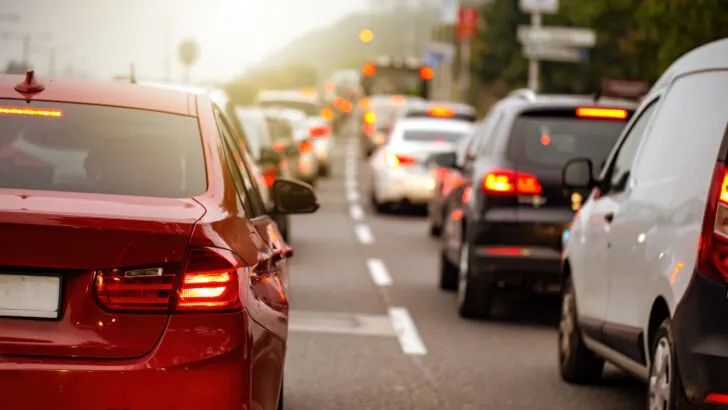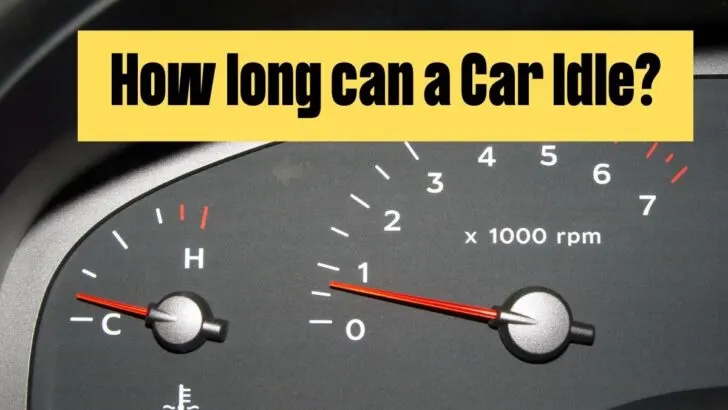Idling your car is a common practice among most car owners, whether you’re sitting in traffic or warming it up on a cold day, but how long can a car idle?
A car can idle for as long as there is fuel in the fuel tank. While most experts recommend that you don’t leave your car idling for more than a few minutes in order to reduce unnecessary emissions, in all reality, there aren’t many significant risks to letting your car idle for longer.
Chances are that if you drive your car on a regular basis, you sit in your car while it’s idling all the time. Whether you’re leaving a passenger in the car while you quickly stop in a store or sitting in rush hour traffic on the way to work, idling is something that most of us do without even thinking about it.
However, knowing more about the risks of letting your car idle for too long can help you avoid any unnecessary problems that might come up as well as reduce the amount of emissions that your car lets out into the air.
What Is Idling?
Before we get into the details of how long a car can idle and what risks come with doing so, it’s important to make sure that you know exactly what idling is and when you are most likely to do it.
In short, your car is idling anytime that it is turned on and not driving. As soon as you start up the engine, the car is in an idle state, meaning that it has power coming from the engine which could begin moving the car at any moment.
While in park, an idling car will not move, as it is restricted by the transmission and brakes. However, if you shift into drive or reverse, the idling engine will begin to slowly move the car forward or backward, as burning the minimum amount of fuel needed to keep the engine running still produces enough energy to move the vehicle.

You’ve probably noticed this and use the slow movement of your vehicle’s idling engine all the time when you are squeezing into a tight parking spot on the street or slowly inching up closer to an intersection.
There are many other situations where you might find yourself letting your car idle for extended periods of time. Any sort of traffic caused by an accident, construction, or simply rush hour can easily leave drivers sitting in their idling cars for far longer than they’d like.
Many people also turn their cars on and let them idle on cold winter mornings so that the engine has time to get warm and the car has time to defrost the windows and warm up the interior.
No matter what the situation, idling is as common of a driving practice as stopping at a red light, so knowing what the consequences of letting your car idle for a while are is incredibly important for every driver on the road.
How Long Can a Car Idle?
Now that we know exactly what idling is and some of the most common situations we do it in, how long can you actually let your car idle for?
In theory, given unlimited fuel, a car could idle forever. This means that the amount of time your car will be able to idle is completely dependent on how much gas you have in the tank.
However, most experts recommend that you don’t let your car idle for more than a few minutes at a time. While the risks to your actual car are minuscule, as long as your car is running it is burning fuel and emitting harmful gases into the air.
Avoiding idling whenever and wherever you can help potentially help you save a bit on fuel, and help the environment by reducing emissions that come from your vehicle.
What About Diesel Vehicles?
It is worth noting that if you have a vehicle with a diesel engine, idling for a minute or two on a regular basis is necessary to clear all of the exhaust fumes that build up over time. Failing to do this will likely cause your vehicle to pollute the air with even more emissions than normal.
However, while this is a necessary part of maintaining a diesel engine, you don’t need to do this if you have a car with a normal internal combustion engine.
What Risks Come With Letting Your Car Idle For Extended Periods of Time?
While there are plenty of rumors and myths about idling being bad for your car, nowadays, these myths are largely untrue. While idling may have been bad for your car at one time, there really isn’t much risk to letting modern-day cars idle for extended periods of time.
Of course, if you do choose to idle your car for a while, you should be aware that as long as your car is idling, it is also burning fuel. Though on average, most vehicles burn less than one-fifth of a gallon of gas per hour while idling.

Idling for extended periods of time may also drain your car’s battery. Anytime the engine is on the alternator is also running, providing enough energy to continuously charge the battery. However, if you are also using other features that use up power, like the radio, headlights, or any other electrical components, you will risk completely draining your battery of power.
In rare cases, idling may also cause your engine to overheat, though this is only likely to happen if there is some other problem with your car. Still, the longer you let your car idle for, the more of a chance it has of overheating.
When Is It Okay To Idle?
Again, to avoid unnecessary pollution, you should never really let your car idle for long, however, there are some situations that pose little to no threat to yourself or your vehicle, where it may be necessary or convenient to keep your car idling.
Heavy traffic is a no-brainer when it comes to a situation where it may be necessary to let your car idle for a while. If you’re really stuck in standstill traffic and are left standing still for multiple minutes you may as well turn your car off. However, if you are stopping and slowly inching forward every few seconds, it really doesn’t make any sense to keep turning off and restarting your car.
Stopping for stop lights is another situation where you’re probably better off letting your car idle. Even if it is a long light that lasts more than a minute, there’s really no reason for you to turn your car off, especially if there are impatient people behind you that might not appreciate the extra seconds it will take to get moving when the light turns green.
The only other situation where it may be beneficial to keep your car idling is if you are low on gas and need to get to a gas station, as turning your car off and on again burns up more fuel than simply letting it idle.
Key Takeaways to How Long Your Car Can Idle
Your car can idle as long as there is gas in the gas tank.
You should never idle for more than a few minutes to reduce unnecessary harmful emissions.
You may risk running out of gas, draining your battery, or overheating your engine if you let your car idle for too long.
It is perfectly fine to let your car idle while waiting in traffic or at stop lights, or if you are running low on gas and need to get to a gas station.
